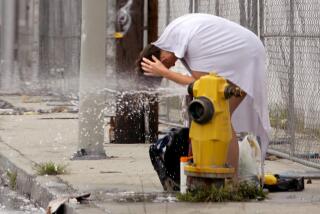Hepatitis C a latent legacy of baby boomers’ youth
- Share via
The number of baby boomers dying from a “silent epidemic” of hepatitis C infections is increasing so rapidly that federal officials are planning a new nationwide push for widespread testing.
Three in four of the estimated 3.2 million people who have chronic hepatitis C — and a similar proportion of those who die from the disease — are baby boomers. Deaths from the virus nearly doubled between 1999 and 2007 to more than 15,000, according to a recent Centers for Disease Control and Prevention study.
Hepatitis C is the leading infectious cause of cirrhosis and liver cancer and is the most common reason for liver transplants in the United States, according to the CDC. In 2007, deaths from the disease surpassed those linked to HIV, and the numbers of fatalities are expected to continue increasing, researchers reported.
“We have sort of a perfect storm of an age wave of people who are moving through time who are progressively becoming sicker from an infection that was acquired several decades ago,” said John Ward, director of the Division of Viral Hepatitis at the CDC. “We think we are at a very critical juncture.”
Many boomers unknowingly contracted the virus in younger years from using drugs or having blood transfusions before screening was improved during the AIDS crisis. Unaware of the risk and without symptoms, most have never been tested for hepatitis C and don’t know they have it. The disease — primarily contracted through blood — often remains hidden for decades while it slowly destroys liver cells. There is no vaccine.
“Hepatitis C is really a stealth virus,” said Elizabeth Bancroft, medical epidemiologist with the Los Angeles County Department of Public Health. “It can live in you for many, many, many years.”
There are at least 530,000 people living with hepatitis C in California, including an estimated 134,000 in Los Angeles County, according to health officials.
Harold Owens, who lives in Los Angeles and works at the Recording Academy, is among those paying the consequences for decisions made in his youth. He developed a heroin habit as a young man but says he hasn’t touched drugs in nearly a quarter-century. He was diagnosed with hepatitis C in 2001. Now 59, he suspects he may have contracted the disease from sharing infected needles.
“I understand the risks now,” said Owens, who directs a foundation for musicians dealing with addiction. “I didn’t then. Nobody did.”
Owens underwent treatment that slowed the disease’s progression but didn’t expel it from his body. He still worries about what it could do to his liver. “It hangs over your head,” he said.
Concerned about the disease among baby boomers, the CDC plans to issue a recommendation this year that everyone born between 1945 and 1965 be tested. Up until now, the federal agency only urged screening for those believed to be at risk. That strategy hasn’t worked, in part because of the stigma — doctors don’t ask about previous drug use and patients don’t offer up the information.
“I certainly would not have come forward that I shot drugs,” said Leslie Benson, 63, of Sacramento, who was diagnosed in 1992.
Benson, who co-founded an advocacy coalition, California Hepatitis Alliance, said she experimented with drugs for a short time in the late 1960s and received five pints of blood after getting into a car accident as a teenager — both of which put her at risk for contracting hepatitis C.
The CDC recommendation is coming in an era when safer, faster and more effective drug treatments are becoming available, and more are being tested. The new medications still have side effects but increase the odds of suppressing the virus and its complications, according to research.
Health officials say the new medications, although they aren’t cheap, are far less costly than liver transplants and liver cancer treatment, which can climb into the hundreds of thousands of dollars.
The disease is “a significant and very costly problem” in California, said Gil Chavez, deputy director of the center for infectious diseases for the state public health department. In California, officials said hospitalization charges for liver disease, cancer and transplants totaled more than $2 billion in 2010.
The state adopted a plan in 2009 to improve education about the disease and to increase access to testing and care, but Chavez said much more needs to be done. The expected federal recommendation for screening baby boomers will help providers and patients understand the dangers, he said.
“I don’t think people have a notion that something they did 20 or 30 years ago may cause them to have an infection today,” Chavez said.
Danny Jenkins, 59, a grant writer, learned he was infected several years ago and underwent a grueling regimen of powerful medications that cleared the virus. A past drug user, he said he was lucky to learn of his infection before he needed a new liver.
A co-chair of the Hepatitis C Task Force for Los Angeles County, he works to raise awareness about the virus and encourage people to get tested.
“Lack of knowledge is everywhere,” he said. “I’m worried about people who don’t know about it and haven’t been tested and may be moving toward liver disease.”






